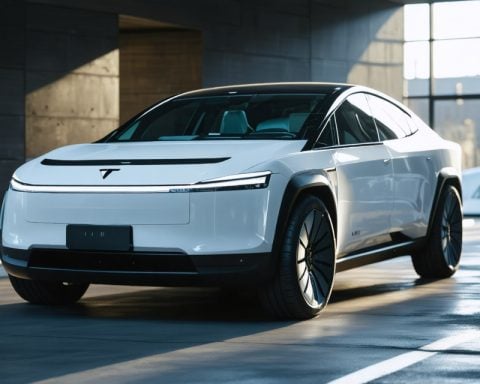- Simple Energy is experiencing significant growth in the electric vehicle sector in Tamil Nadu’s Krishnagiri district.
- The company is preparing for a new Series A funding round to redefine urban mobility.
- Plans are in place to produce 300,000 vehicles annually, with scooters set to increase from 1,000 to 4,000 units monthly by August.
- Revenue expectations reach Rs 400 crore as part of their aggressive expansion strategy.
- Simple Energy aims to expand from 15 to 400 retail stores within 18 months.
- Monthly production is set to rise to 20,000 units, enhancing their national presence.
- The company plans to evolve its product lineup and maintain focus on current strategies before further capacity expansion.
- Simple Energy emphasizes innovation in steering India towards a sustainable electric vehicle future.
In the bustling heart of Tamil Nadu’s Krishnagiri district, an electrifying transformation is underway, fueled by the ambitious vision of Simple Energy. As you read this, the startup is powering up for a seismic leap in the electric vehicle market. With their sights set on a fresh Series A funding infusion, Simple Energy gears up to redefine urban mobility.
Inside the epicenter of their operations, the factory hums with life, its assembly lines ready to churn out an astonishing 300,000 vehicles annually. The founder-CEO, Suhas Rajkumar, embodies a whirlwind of determination and foresight. With funds already secured, the official announcement lies just weeks away, signaling a future without financial constraints—at least in the immediate term.
Picture this: a network of scooters, buzzing through city streets, poised to double from 1,000 to a remarkable 4,000 units every month by August. The revving engines of their serene fleet anticipate a majestic top line of Rs 400 crore, all part of an aggressive strategy to spread Simple Energy’s footprint across the nation.
It’s not just about scooters; it’s about revolutionizing access, carving out a sprawling path of expansion. Envision the leap from a modest 15 stores to an extensive 400, each one a center of innovation and customer connection, all within the next 18 months. Rajkumar and his team have plotted a course where hitting 20,000 monthly units becomes more than aspiration; it becomes their new reality.
Yet, the true magic lies beyond the numbers. As the company’s distribution network flourishes, so does its imagination. Simple Energy isn’t merely manufacturing the future; they’re designing it. By next year, their product lineup will evolve, sprinkling more excitement onto the electric vehicle narrative.
For now, no need looms for capacity expansion. The focus is clear: ignite the current plan, fuel demand, and then—and only then—pump energy into fresh investments. Simple Energy’s story underscores a pivotal mantra: innovation knows no bounds. As the wheels turn smoothly towards a greener tomorrow, Simple Energy stands at the forefront, an electrifying force steering the nation into a sustainable future.
The Electric Revolution: How Simple Energy is Transforming Urban Mobility
Expanding the Horizon: What’s Next for Simple Energy?
Simple Energy’s ambitious plan to dominate the electric vehicle (EV) landscape in India is a testament to vision, innovation, and strategic execution. As the startup garners momentum, particularly with its anticipated Series A funding, it’s crucial to delve deeper into the elements that set Simple Energy apart.
Key Features and Specifications
– Production Capacity: Capable of producing 300,000 electric vehicles annually.
– Current and Future Product Lines: Focuses on electric scooters with plans to diversify into other electric vehicles in the coming years.
– Store Expansion: Plans to increase retail presence from 15 to 400 stores in 18 months.
Market Landscape and Industry Trends
– Rising Demand for EVs: According to the International Energy Agency, electric vehicle sales doubled in 2021, and the trend shows no signs of slowing down.
– Government Incentives: India’s FAME II initiative offers subsidies promoting electric vehicle adoption, supporting manufacturers like Simple Energy.
– Increasing Urban Mobility Needs: Urban populations continue to grow, emphasizing the need for sustainable transportation solutions.
Controversies and Limitations
– Infrastructure Challenges: EVs require extensive charging infrastructure, which in many areas, is still under development.
– Battery Sustainability: While EVs reduce emissions, the environmental impact of battery production and disposal remains a concern.
Real-World Use Cases
– Urban Commuters: Designed for city dwellers looking for efficient, eco-friendly alternatives to traditional scooters.
– Eco-Conscious Consumers: Appeals to those focused on reducing carbon footprints.
– Businesses: Rooftop fleets for delivery companies looking to green their logistics operations.
Emerging Predictions and Insights
– Scaling Innovations: As technology advances, we can expect improvements in battery life, efficiency, and vehicle design.
– Government Policies: Stricter emissions regulations are likely to accelerate EV adoption.
– Consumer Trends: Millennials and Gen Z show growing interest in sustainable products, influencing market shifts.
How-To Steps & Life Hacks: Maximizing Your EV Experience
1. Invest in Home Charging: Installing a home EV charger can reduce dependency on public infrastructure.
2. Stay Informed on Incentives: Monitor government schemes for potential savings.
3. Plan Your Trips: Use EV-specific apps to locate charging stations and optimize routes.
Quick Tips for a Greener Tomorrow
– Consider leasing to stay updated with the latest in EV technology without significant upfront investments.
– Joining EV communities online can provide valuable tips, support, and shared experiences.
Pros & Cons Overview
– Pros: Cost savings on fuel, lower maintenance, contribution to reduced air pollution.
– Cons: Higher initial investment compared to conventional scooters, dependence on emerging charging infrastructure.
For more information on electric vehicles and sustainable transportation, visit Simple Energy.
Simple Energy’s revolutionary approach positions it at the forefront of India’s green transportation movement. With the company’s plans unfolding, potential customers and investors are watching closely as this green force propels the nation toward a more sustainable future.













